Pelles Fiskes biggest inventions
Chapter 1 - Arnes Ant (Arnymyran)
Text: Raven
Photo: The Graylinger
All fly fishermen have some flies that they put more faith in than
others. This article will tell the story about such a fly, and why
the belief in its powers is so strong ....
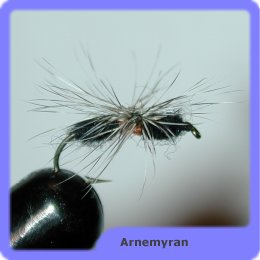 Arnes Ant (Arnemyran in Swedish) was born in the early summer of 1982.
I was fishing Ljustorpsån, a small stream you find a bit north of
Sundsvall. In Ljustorpsån - primarily seen as a trout water -
graylings are relatively numerous, but quite small in size.
Arnes Ant (Arnemyran in Swedish) was born in the early summer of 1982.
I was fishing Ljustorpsån, a small stream you find a bit north of
Sundsvall. In Ljustorpsån - primarily seen as a trout water -
graylings are relatively numerous, but quite small in size.
The glossy surface of the water was occasional disturbed by some
graylings rising - it was time for dry fly fishing. Back in -82, I
preferably fished with very light dressed, Einar
Björkegren-influenced, dry flies, but since Ljustorpsån is a typical
lowland, forrest surrounded river, with a lot of anthills near the
shore, I was interested to try an ant-imitation. In my collection of
various unsorted pattern I found the fly that Pelle many years later
was to name Arnemyran. The fly catched a nice grayling, big enough to
keep, this evening, and thereby lost its innocence - a not too
impressive results may seem, but perfectly acceptable to be a catch in
Ljustorpsån. The fly was tried again, and again, and to this day date
no other patterns have been able to replace it as my natural first
choice at the fishing grounds. Arnemyran has demonstrated great
all-round features and catches fish far up in the mountain areas in
the northern parts of Swedan, as it did in my childhood forrest based
lowland river.
To my experience, it is not easy for a fly pattern to win a fly
fisherman's full and unreserved confidence. The fly must first undergo
a lengthy process, where its ability to attract fish to bite is
constantly compared with the favorites, previously subjected to the
same critical scrutiny. If the pattern is able to meet the fisherman's
high expectation, it can look forward to a bright future as one of the
few fly patterns that share virtually all of the fishing time. But in
addition to regularly catch fish, I think a fly must be a part of a
special occasion before it becoms one of the specially selected -
something happens that the fisherman will never forget. For me and the
ant, this happend in the Norwegian river Glomma.
 Anyone
who is familiar with the fishing around Os in Glomma, knows that a
couple of kilometers downstream the village you find a pier of gravel
a bit out in the river. Outside the pier, the river is slow and the
water is deep. The pool ends up in a more rapids part where, at least
the past, it was common to see some decent grayling. At the occasion
some fish was also active in the slow and deep part of the river, a
bit further up. The fish raised wery quiet and calm, and I judged that
the fish took something that was floating in the water's surface film.
It was time to try the ant. The bite was calm and quiet, just as in
the earlier observed raise. What went wrong, I do not know, but a few
seconds later, I stood there with shaky legs and a broken hook.
Immediately after the strike, the fish taken off to the rapids, and
because the rapid was long and it was impossible to to follow the fish
downstream, it was necessary to try to stop it. I have often wondered
what it was that took the ant, that night at the gravel pier in
Glomma. Was a huge grayling, or maybe a trout? Or, is the fact that
that both the event and the fish has grown larger over the years? The
answer of these questions are not so important anymore. But more
important, that evening, the ant took the final step on its long
journey towards the parlor of the fly-box- a place still occupied
today.
Anyone
who is familiar with the fishing around Os in Glomma, knows that a
couple of kilometers downstream the village you find a pier of gravel
a bit out in the river. Outside the pier, the river is slow and the
water is deep. The pool ends up in a more rapids part where, at least
the past, it was common to see some decent grayling. At the occasion
some fish was also active in the slow and deep part of the river, a
bit further up. The fish raised wery quiet and calm, and I judged that
the fish took something that was floating in the water's surface film.
It was time to try the ant. The bite was calm and quiet, just as in
the earlier observed raise. What went wrong, I do not know, but a few
seconds later, I stood there with shaky legs and a broken hook.
Immediately after the strike, the fish taken off to the rapids, and
because the rapid was long and it was impossible to to follow the fish
downstream, it was necessary to try to stop it. I have often wondered
what it was that took the ant, that night at the gravel pier in
Glomma. Was a huge grayling, or maybe a trout? Or, is the fact that
that both the event and the fish has grown larger over the years? The
answer of these questions are not so important anymore. But more
important, that evening, the ant took the final step on its long
journey towards the parlor of the fly-box- a place still occupied
today.
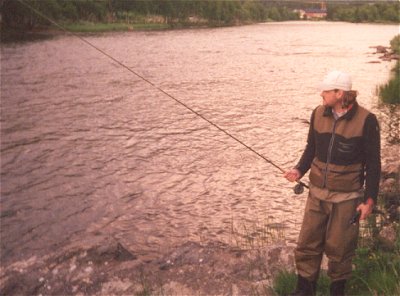 The
first version of the ant had a brown hackle, and I have tried all
possible coulors since then. One reason that the main pattern has a
grizzle-hackle is that it then becomes easier to see the fly on the
water surface, and another is that grizzle hackles generally are of
excellent quality, higher than other coulors - noticable even in these
times of high quality Witting Farms produced necks. You can vary the
coulor of the hackle, but changing the body colors has never proven
successful, and I claim that the body must have the colors that are
specified below.
The
first version of the ant had a brown hackle, and I have tried all
possible coulors since then. One reason that the main pattern has a
grizzle-hackle is that it then becomes easier to see the fly on the
water surface, and another is that grizzle hackles generally are of
excellent quality, higher than other coulors - noticable even in these
times of high quality Witting Farms produced necks. You can vary the
coulor of the hackle, but changing the body colors has never proven
successful, and I claim that the body must have the colors that are
specified below.
Finally, a few tips on how to fish the ant. If the fish are active in
the surface, it is really no question about how to fish the fly -
classic dry fly fishing is what you do. One of the real merits of the
ant are shown when the fish do not really breaks the surface, and
instead clearly are taking something just under the same. In this
case, cast upstream and drawn the fly, with a small jolt, just below
the surface. After this, you have to keep track of where the fly it is
located, and do the counter-thrust when a movement is visible close to
where the fly should be. For the lazy fisherman it is also recommended
to soak the ant properly and fish it as a wet fly - several graylings
has been caught that way. With this said, Arnes Ant is really an
all-rounder that can save you some headache when searching for fish in
a new fishing water. Hopefully, on some occasion it will be the
difference between an empty fish basket, something that most of us
know can cause a great amusement for our fishing buddies, or not. Good
luck!
Tying the Arnes Ant
Material
You will need the following materials:
- Hook. Dry fly hook size 12 or 14, for example Mustad 94833
- Thread. We choose a black thread.
- Parachute hackle base. We use an ordinary nylon leader, 0,20, for
this.
- Hackle. We tie a parachute hackel - grizzle of better quality.
- Body. Front- and rear-parts are made of Flytite #2 (black), and the
middle section are made by Flyrite #5 (rust).
Description
Step 1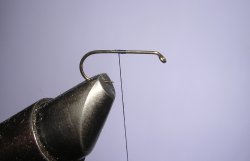 Begin about in the middle of the shaft. |
Step 2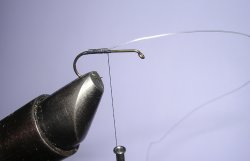 Tie the thread back to where shaft ends and tie in the nylon thread, pointing forward. |
Step 3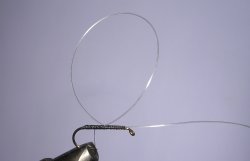 Make a loop of nylon thread and fix it on the front of the shaft with loose turns. Then go back with thread to the middle of the back half of the shaft. |
Step 4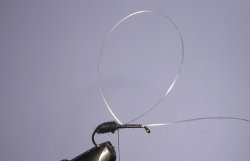 Create the rear body-part with black dubbing - leave a couple of milimeters without dubbing nearest the nylon thread. |
Step 5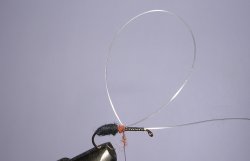 Apply a thin layer of rust dubbing between the black abdomens and the nylon loop. |
Step 6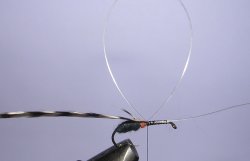 Attace the hackle - remember to fix it as firm as possible, but without the risk it will loose. |
Step 7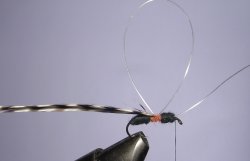 Create the rest of the body; first a thin layer of rust dubbing closest to nylon loop, and then black dubbing forming the rest of the body. Create the head under the nylon line. |
Step 8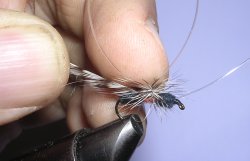 The parachute hackle is created around the nylon loop, four to five laps. Make sure that every lap are wrapped under the lap tied in before. |
Step 9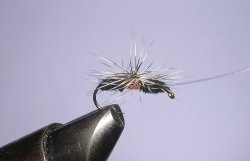 In the end, the hackle is placed through the nylon loop, and carefully tighten by pulling the nylon thread by the head. If you pull too violent, there is a risk that the hackle breaks. |
Step 10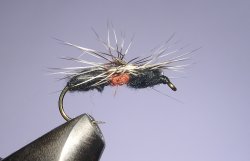 Cut the nylon string at the head, put a drop of varnish at the base of the parachute hackle and pressure it down with your thumb to get the correct shape, and finally we have our Arnemyra! |
We apologize for the poor English...
/The Graylinger and Raven